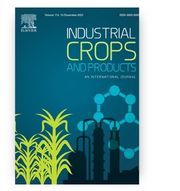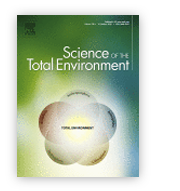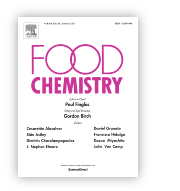
Research papers of the month – April 2022
We present the highest-score research papers of April 2022. These papers have ben published in journals with the highest Ministerial score – 200 points.
Crambe – Energy efficiency of biomass production and mineral fertilization. A case study in Poland
Krzysztof Józef Jankowski, Mateusz Sokólski, Artur Szatkowski, Marcin Kozak
Industrial Crops and Products
Ministerial score = 200.0
Journal Impact Factor (2020) = 5.654 (Q1)
 Crambe (Crambe abyssinica Hochst. ex R.E. Fries) is an annual oilseed plant belonging to the family of Brassicaceae. It is mostly cultivated for its high level of erucic acid. Crambe was field tested in Bałcyny in north-eastern (NE) Poland in 2017–2019 to evaluate the effects of nitrogen (N) and sulfur (S) fertilization on the energy efficiency in the production of hulled seeds and total biomass (hulled seeds and straw). The N fertilizer rate (0, 30, 60, 90, and 120 kg ha−1) and the S fertilizer rate (0, 15, and 30 kg ha−1) were the experimental variables. The energy input in the production technology without N and S fertilization was determined at 5.52 GJ ha−1. The highest N (120 kg ha−1) and S (30 kg ha−1) rates caused a 2.7-fold increase in energy inputs. In NE Poland, crambe yields ranged from 1.14 to 1.78 (hulled seeds) and from 1.70 to 2.53 Mg ha−1 DM (straw). The energy output in crambe production was 26.13–40.56 (seeds only) and 56.06–77.64 GJ ha−1 (seeds and straw). The highest energy gain was noted after the application of 60 kg N ha−1 and 30 kg S ha−1 (25.57 GJ ha−1 in seeds) or 90 kg N ha−1 and 30 kg S ha−1 (50.25 GJ ha−1 in total biomass). The energy efficiency ratio of seeds (4.74–4.96) and total biomass (9.54–9.85) was highest in the production technology without N fertilization. Nitrogen (120 kg ha−1) induced a nearly 2-fold decrease in the energy efficiency ratio of seeds and total biomass. Sulfur had a positive influence on the energy output (increase of 3–20%), energy gain (increase of 3–31%) and the energy efficiency ratio (increase of 3–17%) of crambe. The incorporation of S into the N fertilization regime alleviated the decrease in the energy efficiency ratio of crambe production induced by increasing N fertilizer rates.
Crambe (Crambe abyssinica Hochst. ex R.E. Fries) is an annual oilseed plant belonging to the family of Brassicaceae. It is mostly cultivated for its high level of erucic acid. Crambe was field tested in Bałcyny in north-eastern (NE) Poland in 2017–2019 to evaluate the effects of nitrogen (N) and sulfur (S) fertilization on the energy efficiency in the production of hulled seeds and total biomass (hulled seeds and straw). The N fertilizer rate (0, 30, 60, 90, and 120 kg ha−1) and the S fertilizer rate (0, 15, and 30 kg ha−1) were the experimental variables. The energy input in the production technology without N and S fertilization was determined at 5.52 GJ ha−1. The highest N (120 kg ha−1) and S (30 kg ha−1) rates caused a 2.7-fold increase in energy inputs. In NE Poland, crambe yields ranged from 1.14 to 1.78 (hulled seeds) and from 1.70 to 2.53 Mg ha−1 DM (straw). The energy output in crambe production was 26.13–40.56 (seeds only) and 56.06–77.64 GJ ha−1 (seeds and straw). The highest energy gain was noted after the application of 60 kg N ha−1 and 30 kg S ha−1 (25.57 GJ ha−1 in seeds) or 90 kg N ha−1 and 30 kg S ha−1 (50.25 GJ ha−1 in total biomass). The energy efficiency ratio of seeds (4.74–4.96) and total biomass (9.54–9.85) was highest in the production technology without N fertilization. Nitrogen (120 kg ha−1) induced a nearly 2-fold decrease in the energy efficiency ratio of seeds and total biomass. Sulfur had a positive influence on the energy output (increase of 3–20%), energy gain (increase of 3–31%) and the energy efficiency ratio (increase of 3–17%) of crambe. The incorporation of S into the N fertilization regime alleviated the decrease in the energy efficiency ratio of crambe production induced by increasing N fertilizer rates.
DOI:10.1016/j.indcrop.2022.114918
Metabolic engineering of Yarrowia lipolytica for poly(ethylene terephthalate) degradation
Katarzyna Kosiorowska, Piotr Biniarz, Adam Dobrowolski, Karol Leluk, Aleksandra Mirończuk
Science of the Total Environment
Ministerial score = 200.0
Journal Impact Factor (2020) = 7.963 (Q1)
 Polyethylene terephthalate (PET) is the most widely used plastic, whose global production scale causes serious problems due to it being highly non-biodegradable. The present work provides a novel approach to plastic degradation studies, which involves direct degradation of PET in the culture of a modified Y. lipolytica yeast strain extracellularly producing cutinase from Fusarium solani. In this study, we successfully accomplished a scale-up of the degradation process in culture, which is promising from the perspective of wider application of the developed method in the future. Additionally, we tested the effect of various supplements, which may increase the PET degradation efficiency in the culture of the Y. lipolytica pAD CUT_FS strain. The ability of PET decomposition was verified by the amount of the released degradation products, such as terephthalic acid (TPA) and mono-(2-hydroxyethyl)-terephthalic acid (MHET), during cultivation. We observed that the quantities of TPA and MHET released during the PET degradation process were increasing daily, and were 1.51 gL−1 and 0.45 gL−1, respectively after 240 h of the bioreactor fermentation. Analysis of the PET film by electron microscopy indicated that there was abundant damage on the surface of the material. This study also demonstrated that the engineered Y. lipolytica strain is able to degrade PET at 28 °C during fermentation. The results obtained in this study using amorphous PET powder provide a wide range of possibilities for application of the cutinase-secreting strain of Y. lipolytica on the more difficult to degrade highly crystalline PET films, PET bottles and PET melts.
Polyethylene terephthalate (PET) is the most widely used plastic, whose global production scale causes serious problems due to it being highly non-biodegradable. The present work provides a novel approach to plastic degradation studies, which involves direct degradation of PET in the culture of a modified Y. lipolytica yeast strain extracellularly producing cutinase from Fusarium solani. In this study, we successfully accomplished a scale-up of the degradation process in culture, which is promising from the perspective of wider application of the developed method in the future. Additionally, we tested the effect of various supplements, which may increase the PET degradation efficiency in the culture of the Y. lipolytica pAD CUT_FS strain. The ability of PET decomposition was verified by the amount of the released degradation products, such as terephthalic acid (TPA) and mono-(2-hydroxyethyl)-terephthalic acid (MHET), during cultivation. We observed that the quantities of TPA and MHET released during the PET degradation process were increasing daily, and were 1.51 gL−1 and 0.45 gL−1, respectively after 240 h of the bioreactor fermentation. Analysis of the PET film by electron microscopy indicated that there was abundant damage on the surface of the material. This study also demonstrated that the engineered Y. lipolytica strain is able to degrade PET at 28 °C during fermentation. The results obtained in this study using amorphous PET powder provide a wide range of possibilities for application of the cutinase-secreting strain of Y. lipolytica on the more difficult to degrade highly crystalline PET films, PET bottles and PET melts.
DOI:10.1016/j.scitotenv.2022.154841
UPLC/ESI-Q-TOF-MS analysis of (poly)phenols, tocols and amino acids in Chaenomeles leaves versus in vitro anti-enzyme activities
Igor Turkiewicz, Aneta Wojdyło, Karolina Tkacz, Paulina Nowicka
Industrial Crops and Products
Ministerial score = 200.0
Journal Impact Factor (2020) = 5.645(Q1)
 The aim of this study was to investigate the content of phenolics, free amino acids, tocopherols, tocotrienols and in vitro biological activities (α-amylase, α-glucosidase, and pancreatic lipase inhibition activity) of 12 cultivars of Chaenomeles × superba, japonica and speciosa leaves. In the present work 39 phenolic compounds were tentatively identified, including polymeric procyanidins > flavan-3-ols > phenolic acids > flavonols > flavanones > flavones > ellagitannins. Chaenomeles leaves contained on average 16.8 g of phenolics per 100 g dry weight (dw), with C. × superba ˈNicolineˈ displaying the highest (27.5 g/100 g dw), and C. × superba ˈColour Trailˈ the lowest (7.7 g/100 g dw) total phenolic content. Chaenomeles leaves possess all eight tocol analogs (four tocopherols (TP), and four tocotrienols (TT)), ranked in decreasing content: α-TP > β-TP > γ-TP > δ-TP > α-TT > β-TT > δ-TT > γ-TT. The most active form (α-tocopherol) was present in amounts from 480.6 to 7201.1 µg/100 g dw. 23 amino acids were identified, including all nine essential amino acids. The highest amount of O-phospho-L-serine was found (average 249.2 mg/100 g dw). Leaves of C. japonica ˈRed Joyˈ displayed the highest total amino acid content (2735.2 mg/100 g dw). Chaenomeles leaves showed α-amylase (8.2–24.5 mg/mL), α-glucosidase (1.2-6.3 mg/mL), and pancreatic lipase (7.0-10.5 mg/mL) inhibition activity (expressed as half maximal inhibitory concentration, IC50). Chaenomeles leaves can be a good material for obtaining extracts rich in phenolics, vitamin E or amino acids, providing an alternative, natural source of these compounds to help meet the growing demand for nutraceuticals and supplements.
The aim of this study was to investigate the content of phenolics, free amino acids, tocopherols, tocotrienols and in vitro biological activities (α-amylase, α-glucosidase, and pancreatic lipase inhibition activity) of 12 cultivars of Chaenomeles × superba, japonica and speciosa leaves. In the present work 39 phenolic compounds were tentatively identified, including polymeric procyanidins > flavan-3-ols > phenolic acids > flavonols > flavanones > flavones > ellagitannins. Chaenomeles leaves contained on average 16.8 g of phenolics per 100 g dry weight (dw), with C. × superba ˈNicolineˈ displaying the highest (27.5 g/100 g dw), and C. × superba ˈColour Trailˈ the lowest (7.7 g/100 g dw) total phenolic content. Chaenomeles leaves possess all eight tocol analogs (four tocopherols (TP), and four tocotrienols (TT)), ranked in decreasing content: α-TP > β-TP > γ-TP > δ-TP > α-TT > β-TT > δ-TT > γ-TT. The most active form (α-tocopherol) was present in amounts from 480.6 to 7201.1 µg/100 g dw. 23 amino acids were identified, including all nine essential amino acids. The highest amount of O-phospho-L-serine was found (average 249.2 mg/100 g dw). Leaves of C. japonica ˈRed Joyˈ displayed the highest total amino acid content (2735.2 mg/100 g dw). Chaenomeles leaves showed α-amylase (8.2–24.5 mg/mL), α-glucosidase (1.2-6.3 mg/mL), and pancreatic lipase (7.0-10.5 mg/mL) inhibition activity (expressed as half maximal inhibitory concentration, IC50). Chaenomeles leaves can be a good material for obtaining extracts rich in phenolics, vitamin E or amino acids, providing an alternative, natural source of these compounds to help meet the growing demand for nutraceuticals and supplements.
DOI:10.1016/j.indcrop.2022.114829
Utilisation of soybean post-production waste in single- and double-layered films based on furcellaran to obtain packaging materials for food products prone to oxidation
Ewelina Jamróz, Joanna Tkaczewska, Marzena Zając, Paulina Guzik, Lesław Juszczak, Agnieszka Kawecka, Katarzyna Turek, Małgorzata Zimowska, Aneta Wojdyło
Food Chemistry
Ministerial score = 200.0
Journal Impact Factor (2020) = 7.514(Q1)
 Single-layered films, based on furcellaran and protein hydrolysates from soybean bran (1st layer), were obtained. Moreover, a procedure for the preparation of double-layered films was developed, in which an ethanol extract from soybean bran was deposited onto the 1st layer. It was checked how the addition of the 2nd layer affects the functional properties of the film. The addition of the 2nd layer increased the thermal properties, modulus of elasticity and antioxidant activity, while decreases were noted for tensile strength and elongation at break parameters. The films were used as packaging materials for storing butter and the active films did not extend the quality of butter during storage, however, they behaved in the same way as synthetic films. Therefore they have the potential to be used as packaging material instead of a synthetic film.
Single-layered films, based on furcellaran and protein hydrolysates from soybean bran (1st layer), were obtained. Moreover, a procedure for the preparation of double-layered films was developed, in which an ethanol extract from soybean bran was deposited onto the 1st layer. It was checked how the addition of the 2nd layer affects the functional properties of the film. The addition of the 2nd layer increased the thermal properties, modulus of elasticity and antioxidant activity, while decreases were noted for tensile strength and elongation at break parameters. The films were used as packaging materials for storing butter and the active films did not extend the quality of butter during storage, however, they behaved in the same way as synthetic films. Therefore they have the potential to be used as packaging material instead of a synthetic film.
DOI:10.1016/j.foodchem.2022.132883










